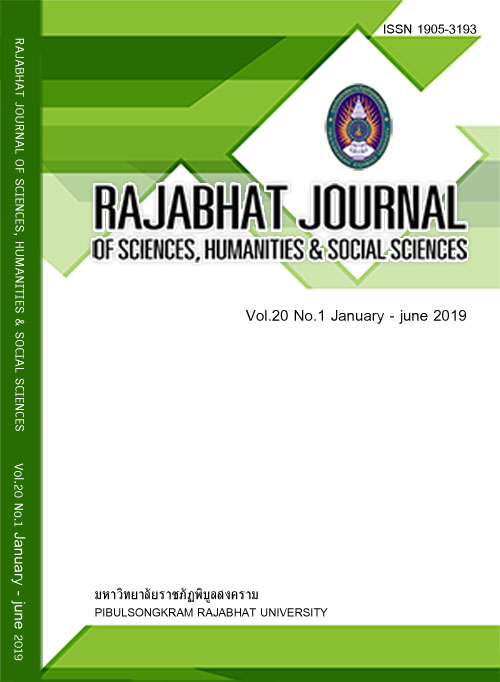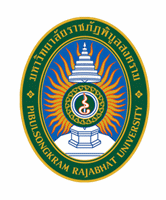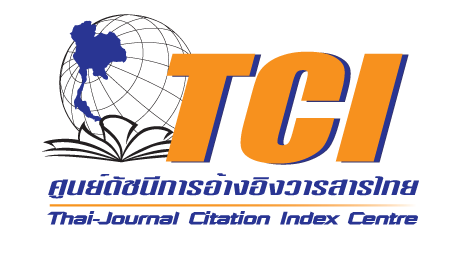ประสิทธิภาพของแบคทีเรียผลิตเอนไซม์เคราติเนสที่แยกได้จากดิน ของฟาร์มสัตว์ปีกในการย่อยสลายขนไก่
คำสำคัญ:
ขนไก่, เอนไซม์, แบคทีเรียย่อยสลายขนไก่, สภาวะที่เหมาะสมบทคัดย่อ
ในแต่ละปีประเทศไทยมีขนไก่ที่เหลือจากกระบวนการผลิตไก่เนื้อจำนวนมากและมักจะถูกกำจัดโดยการเผาซึ่งทำให้เกิดมลพิษทางอากาศ อย่างไรก็ตามขนไก่สามารถใช้เป็นแหล่งโปรตีนในอาหารสัตว์ได้โดยใช้จุลินทรีย์ย่อยสลายขนไก่ ในงานวิจัยนี้จึงมีวัตถุประสงค์เพื่อทดสอบความสามารถของแบคทีเรียในการย่อยสลายขนไก่โดยนำแบคทีเรียที่แยกได้จากดินของฟาร์มสัตว์ปีกในจังหวัดพิษณุโลกที่ทำให้เกิดวงใสบนอาหาร skim milk agar จำนวน 18 ไอโซเลท (PSRU 1–PSRU 18) มาทดสอบประสิทธิภาพในการย่อยสลายขนไก่ในอาหารจำกัดพบว่าแบคทีเรียทั้ง 18 ไอโซเลท สามารถย่อยสลายขนไก่ได้แต่มีประสิทธิภาพต่างกัน อีกทั้งยังได้จัดจำแนกสายพันธุ์ของแบคทีเรียที่สามารถย่อยสลายขนไก่ โดยใช้วิธีการย้อมสีแกรม ลักษณะทางสัณฐานวิทยาและการทดสอบทางชีวเคมี พบว่าสามารถแยกแบคทีเรียได้เป็น Staphylococcus sp. 9 ไอโซเลท Bacillus sp. 7 ไอโซเลท และ Corynebacterium sp. 2 ไอโซเลท โดยแบคทีเรียที่มีประสิทธิภาพในการย่อยสลายขนไก่สูงที่สุด 3 อันดับแรก ได้แก่ ไอโซเลท PSRU 8 PSRU 11 และ PSRU 12 และเมื่อนำแบคทีเรียทั้ง 3 ไอโซเลท มาศึกษาผลของอุณหภูมิที่ 30, 37, 40, 50 และ 60 องศาเซลเซียส และค่าพีเอช 4.5, 6.0, 7.5, 9.0 และ 10.5 ต่อประสิทธิภาพในการย่อยสลายขนไก่ พบว่าแบคทีเรียไอโซเลท PSRU 11 สามารถย่อยสลายขนไก่ได้ดีที่สุดเท่ากับ 73.60 เปอร์เซ็นต์ ที่อุณหภูมิ 37 องศาเซลเซียส และค่าพีเอช 7.5 และจากการจัดจำแนกชนิดของแบคทีเรียทั้ง 3 ไอโซเลท ด้วยเทคนิคทางชีวโมเลกุล พบว่าไอโซเลท PSRU 8 PSRU 11 และ PSRU 12 มีความใกล้เคียงกับ Bacillus cereus B. subtilis และ B. siamensis ตามลำดับ ผลจากการศึกษานี้เป็นแนวทางสำหรับการลดการกำจัดขนไก่ที่อาจจะส่งผลกระทบต่อสิ่งแวดล้อม และเป็นการเพิ่มมูลค่าให้กับของเหลือทิ้งโดยนำไปใช้ในการผลิตแหล่งโปรตีนในอาหารสัตว์
References
Brosius J, Palmer L, Kennedy JP. et al. Complete nucleotide sequence of a 16s ribosomal RNA gene from Escherichia coli. Proceedings of the National Academy of Sciences of the United States of America. 1978; 75: 4801-4805.
Bockle B, Galunsky B, Muller R. Characterization of a kerationlytic serine protease from Streptomyces pactum DSM. 40530. Applied and Environmental Microbiology. 1995; 61: 3705-3710.
Eksittikul T, Kudan S. Isolation and partial purification of keratinase from novel bacteria isolated from poultry farm soil. Ramkhamhaeng Research Journal of Sciences and Technology. 2012; 15: 45-54.
Gupta R, Ramnani P. Microbial keratinases and their prospective applications: an overview. Applied and Environmental Microbiology. 2006; 70: 21-33.
Kim JM, Lim WJ, Suh HJ. Feather-degrading Bacillus species from poultry waste. Process Biochemistry. 2001; 37: 287-291.
Lane DJ, Pace B, Olsen G.J. et al. Rapid determination of 16S ribosomal RNA sequences for phylogenetic analysis. Proceedings of the National Academy of Sciences U.S.A. 1985; 82: 6955–6959.
Laskhmi PJ, Chitturi ChMK, Lakshmi VV. Efficient degradation of feather by keratinase producing Bacillus sp. International Journal of Microbiology. 2013; 2013, 1-7.
Lin X, Kelemen DW, Miller ES. et al. Nucleotide sequence and expression of kerA, the gene encoding a keratinolytic protease of Bacillus licheniformis PWD-1. Applied and Environmental Microbiology. 1995; 61: 1469-1474.
Macedo AJ, Beys da Silva WO, Gava R. et al. Novel keratinase from Bacillus subtilis S14 exhibiting remarkable dehairing capabilities. Applied and Environmental Microbiology. 2005; 71: 594-596.
Prasad HV, Kumar G, Karthik L. et al. Screening of extracellular keratinase producing bacteria from feather processing areas in Vellore, Tamil Nadu. Indian Journal of Scientific Research. 2010; 2: 559-565.
Riffel A, Brandelli A. Keratinolytic bacteria isolated from feather waste. Brazilian Journal of Microbiology. 2006; 37: 395-399.
Scott JA, Untereiner WA. Determination of keratin degradation by fungi using keratin azure. Medical Mycology. 2004; 42: 239-246.
Shih JCH, Williums CM. (1990). Feather-lysate, a hydrolyzed feather feed ingredient and animal feeds containing the same. US patent. 4, 908, 220. 4p.
Sivakumar T, Shankar T, Thangapandian V. et al. Optimization of cultural condition for keratinase production using Bacillus cereus TS1. Insight Microbiology. 2013; 1-8.
Sneath PHA, Mair NS, Sharpe ME. et al. Bergey’s manual of systematic bacteriology, vol 2 Baltimore: Williums and Wilkins. 1986. ISBN0-683-07893-3.
Wanchaitanawong P, Ritthitham S, Nitisinprasert S. Production of keratinase by Bacillus licheniformis KUB-K0006 and Bacillus pumilus KUB-K0082. Proceedings of the 38th Kasetsart University Annual Conference: Engineering, Agro-Industry. 2000; 522-528.
Downloads
เผยแพร่แล้ว
How to Cite
ฉบับ
บท
License
Each article is copyrighted © by its author(s) and is published under license from the author(s).









